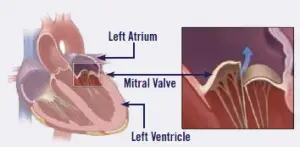
Did you know that nearly 50 percent of all Cavaliers develop a valve murmur by the age of 4 or 5, and nearly all Cavaliers show a murmur by 10 years of age?
This staggering statistic highlights the critical nature of MVD in this beloved breed, a progressive condition that affects the heart and can lead to serious health complications.
This article delves into the symptoms, progression, and management of MVD, offering essential insights for owners to better care for their pets.
Understanding MVD in Cavalier King Charles Spaniels
Mitral Valve Disease (MVD) is a heart disorder that commonly affects Cavalier King Charles Spaniels. As Cavalier King Charles Spaniels age, a degenerative thickening and progressive deformity can develop that causes the mitral valve (located in the heart between the left atrium and left ventricle) to leak.
Over time, the leak can result in blood pooling behind the heart, causing fluids to accumulate in the lungs and sometimes leading to congestive heart failure.
Unfortunately, there is no prevention and no known cure today for MVD. In mild cases, your Cavalier King Charles Spaniel may have no obvious symptoms of mitral valve disease.
In more advanced cases, a Cavalier King Charles might exhibit heavy breathing, coughing, and reluctance to exercise. On rare occasions, the mitral valve can tear, causing fever and respiratory illness.
Veterinarians may initially detect mitral valve disease as a heart murmur. A chest x-ray can help evaluate whether the heart has enlarged, but an echo-cardiogram is necessary for a definitive diagnosis. Moderate cases are generally not treated at this stage.
Cavalier King Charles Spaniels with advanced mitral valve disease or congestive heart failure may be treated with diuretics (to increase urine to eliminate excess fluids) and vasodilators (to dilate blood vessels) to provide relief and extend the dog’s life. Surgical valve repair or replacement may be an option for some Cavalier Spaniel dogs.
The American Cavalier King Charles Spaniel Club warns that mitral valve disease is a particular problem for this breed. Let’s now closely examine the symptoms and progression of MVD in Cavaliers.
Symptoms and Progression of Mitral Valve Disease (MVD)
Early Stage Symptoms:
- Heart Murmur: The earliest detectable sign of MVD, usually identified during a routine veterinary check-up.
- Mild Coughing: Occasional coughing, especially after exercise or at night.
- Reduced Activity Levels: Slight decrease in energy, where the dog may tire more easily during play or walks.
Mid Stage Symptoms:
- Persistent Coughing: More frequent and noticeable coughing.
- Breathing Difficulties: Difficulty breathing, especially after exertion.
- Fatigue: Increased lethargy and less interest in physical activities.
Advanced Stage Symptoms:
- Rapid Breathing: Rapid, labored breathing even during rest.
- Exercise Intolerance: Marked intolerance to exercise; the dog may avoid activity altogether.
- Signs of Congestive Heart Failure: Such as fluid accumulation in the lungs, leading to severe coughing, difficulty breathing, and potentially a bluish tint to the gums due to lack of oxygen.
Living with Mitral Valve Disease
Dietary Adjustments:
- Low Sodium Diet: To help manage fluid retention.
- High-Quality Protein: To maintain muscle mass and overall health.
- Omega-3 Fatty Acids: Beneficial for heart health; can be found in fish oil supplements.
- Weight Management: Keeping your dog at a healthy weight to reduce the strain on the heart.
Exercise Management:
- Gentle Exercise: Avoid strenuous activities; opt for gentle walks and play sessions.
- Monitoring: Watch for signs of fatigue or difficulty breathing during exercise.
Regular Veterinary Care:
- Routine Check-ups: Essential for monitoring the progression of MVD and adjusting treatments as needed.
- Echocardiograms: Regular heart scans to assess heart function and the condition of the mitral valve.
Home Care:
- Comfortable Resting Area: Ensure your dog has a quiet and comfortable place to rest.
- Stress Reduction: Try to minimize stressful situations, as stress can exacerbate heart conditions.
- Close Observation: Keep a close eye on your dog for any changes in behavior, appetite, or energy levels.
- Affection and Comfort: Regular affection and comfort are vital for a dog living with a chronic condition.
FAQs
What causes MVD in Cavalier King Charles Spaniels?
MVD in Cavalier King Charles Spaniels is primarily caused by a degenerative process, where the mitral valve thickens and deforms over time. This genetic predisposition is common in the breed, leading to valve leakage and heart issues as the dog ages.
Can MVD be prevented?
Currently, there is no known way to prevent MVD in Cavalier King Charles Spaniels, as it is largely genetic. However, regular veterinary check-ups and a healthy lifestyle may help in early detection and management of the condition.
How often should a Cavalier with MVD see a veterinarian?
A Cavalier with MVD should have regular veterinary check-ups every 6 to 12 months, or more frequently if advised by a veterinarian. Regular monitoring is crucial to assess the progression of the disease and adjust treatments as necessary.
What is the life expectancy of a Cavalier with MVD?
The life expectancy of a Cavalier with MVD varies widely and depends on the severity and progression of the disease. Early detection and proper management can help in prolonging a good quality of life, but severe cases can lead to a shortened lifespan.